
“Building anything from scratch is hard,” keynote speaker Kevin Jorgeson told a packed audience inside the Salt Palace Convention Center at the 2022 CWA Summit in Salt Lake City. Jorgeson’s speech had a hopeful tone, but there was no denying that the climbing gym industry was facing some hard challenges; it was rebounding from the onset of the COVID-19 pandemic, and it was continuing to adapt amid rising inflation and supply chain issues that had plagued industry-related manufacturing for months.
Yet, despite the obstacles, we can now reflect on 2022 and see that it did feature some inspiring stories of perseverance, teamwork and innovation. Perhaps nowhere in the industry was that power of the human spirit needed more than in Ukraine, where climbing gyms became places of resistance and refuge and where businesses strove to keep their staff employed as the war dragged on. The ripples of the conflict and accompanying economic sanctions were felt throughout the industry worldwide, forcing gym builders and developers to find alternatives to keep their projects on track.
“Many key players in the industry source their birch from Russia. With the war in Ukraine and the trade restrictions that followed, many were left seeking alternative options. Ultimately, this led to rising costs and therefore higher prices for potential gym builds,” said Liz Pecknold, Sales Manager at Salt Lake City-based Vertical Solutions. “As of September, the market stabilized; however, the prices for materials still remain higher than we saw in the pre-pandemic era.”
As exemplified by that situation in Ukraine, the climbing gym industry always takes shape in a larger context―and 2022 proved to be no exception in other cases as well. In the United States, specifically, the labor organizing around the country in 2022 included workers at Movement Crystal City in Virginia forming the first climbing gym union in the U.S. This development was particularly noteworthy because Movement is one of the largest climbing gym chains in the world, currently operating 20 locations across seven states. VITAL, which operates 7 facilities across three states, also saw unionizing activity get going last year at its two Manhattan locations. And already this year, workers at Movement Englewood in Denver, Colorado, told CBJ of their intention to form a union, bringing the total number of U.S. climbing gym locations where union organizing is taking place to four instances between three states.
Movement (The Hill) also made headlines for co-hosting with Summit (Plano) the first IFSC Youth World Championships ever held in the U.S. The two Dallas, Texas, gyms and USA Climbing welcomed over 450 young athletes from 38 countries for ten days of record smashing performances. The competition marked the end of an eventful summer stateside that entailed two IFSC World Cups in Salt Lake City and the return of the CWA Summit during the same period.
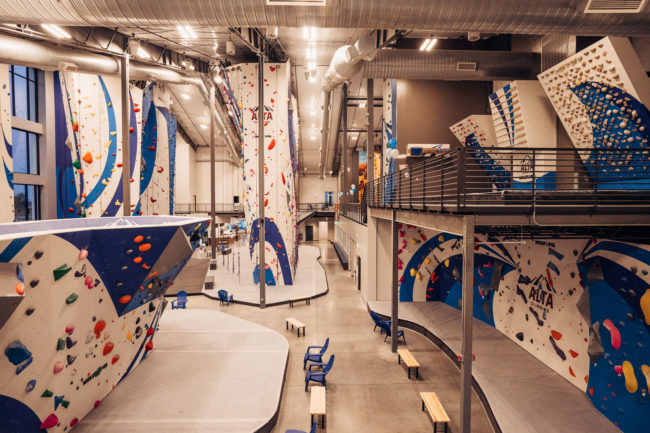
2022 also brought to light some innovative work that’s going on behind the scenes at gyms and brands to drive the industry forward―such as Techtopia unveiling at the CWA Summit its Higher Eye alarm system powered by AI; Head Rush launching the TRUBLUE iQ+ with catch-and-hold capabilities; OnSite pairing virtual reality with more gym designs; and Boulders and The Pad gyms growing their pay what you can memberships as part of the Climb4Community initiative.
But perhaps most noticeable from an industry-wide development standpoint was that 2022 featured the opening of only 36 new climbing gyms in the United States, 20 fewer new gyms than 2021. The resulting net climbing gym growth rate of 4.9 percent was in fact the second lowest growth rate since 2010. From this standpoint, 2022 was somewhat of a down year for new climbing gym development. It also brings to the forefront some larger questions: Was the statistical dip of 2022 indicative of factors other than COVID and supply chain challenges? And are we already starting to approach saturation in certain markets?
To answer these questions and others, this year, the 10th anniversary of CBJ’s Gyms & Trends report, offered an occasion to go beyond single-year statistics and focus on ten-year and five-year growth figures. While recent Gyms & Trends reports have all included historical figures, the spotlight on multi-year growth rates in this 2022 report gives an even clearer window into the bigger picture and long-term state of the industry. Viewed as a whole―and coupled with the insights of experts around the industry―the outlook of the North American climbing gym industry heading into 2023 is far more optimistic than the figures of 2022 alone might suggest. (A full list of the gyms that opened in 2022 can be found here.)
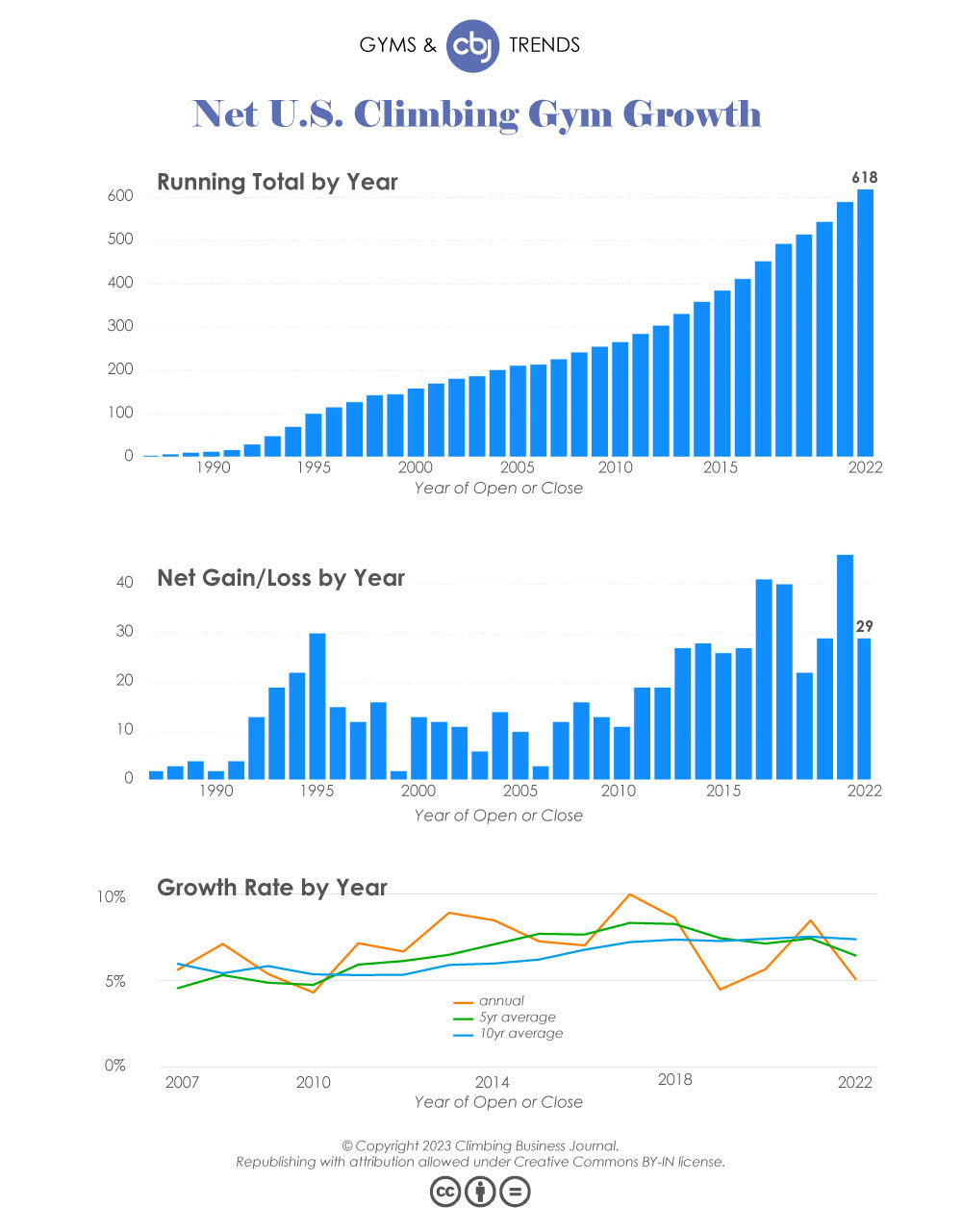
32 net new gyms opened annually in the U.S. on average over the past 10 years (all-time high)
Compared to 2021, 2018 and 2017, when more than 50 new climbing gyms opened each year in the United States, there’s no doubt that a total of 36 new gym openings in 2022 represents a noticeable decline in new gym growth. Like a pig passing through the python, some experts believe we are likely seeing more effects of the COVID pandemic pass through the industry. Whereas many 2020 and even 2021 gym builds were underway before the pandemic’s onset, 2022 projects were planned and constructed in a much different economic and political climate.
“I think everyone is still dealing with COVID fallout, including huge delays and back-ups in manufacturing and shipping that have not totally resolved, financial changes, and the general state of uncertainty in the world,” said Jackie Hueftle, co-owner of Kilter Grips. “It seems that COVID changed the industry’s track in the short term, but the long-term outlook is optimistic.”
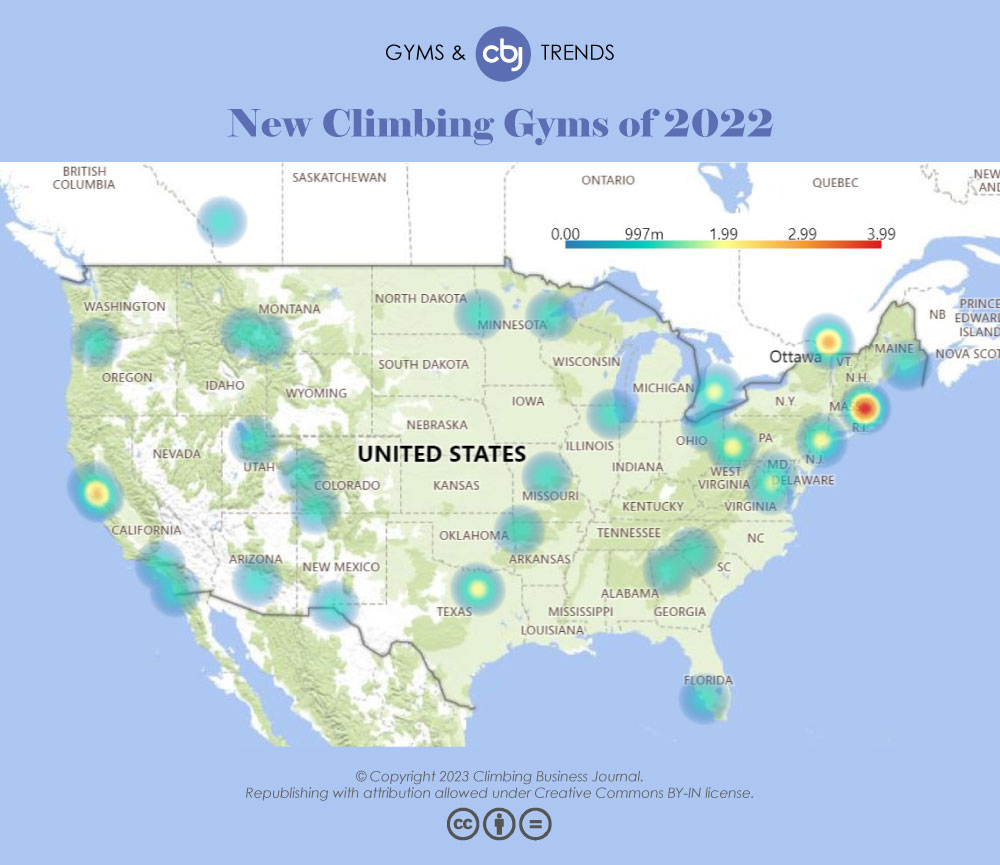
That optimism for the industry’s long-term outlook―shared by the vast majority of industry experts we heard from during research for this Gyms & Trends report―is buoyed by the fact that only 7 U.S. climbing gyms closed in 2022, the fewest of the past eight years and a stark contrast to 20 permanent gym closures during the pandemic-riddled 2020. Indeed, when viewing average net climbing gym growth (annual openings minus permanent closures) over ten-year intervals, the period from 2013-2022 marked the best ten-year period ever, with the U.S. climbing gym industry growing by 32 net gyms on average each year.
Some of the noteworthy developments in 2022, specifically, were Central Rock opening three new gyms in the Boston area (Arsenal Yards, Fenway and Harvard Square)―earning Central Rock its second Developer of the Year award in four years―as well as Walltopia and Rock Gym Pro bringing home the Wall Builder and CRM Software of choice awards in being selected for 33% and 50% of new gym builds, respectively, across the U.S. and Canada. (Click here for all the 2022 Gyms List Awards.)
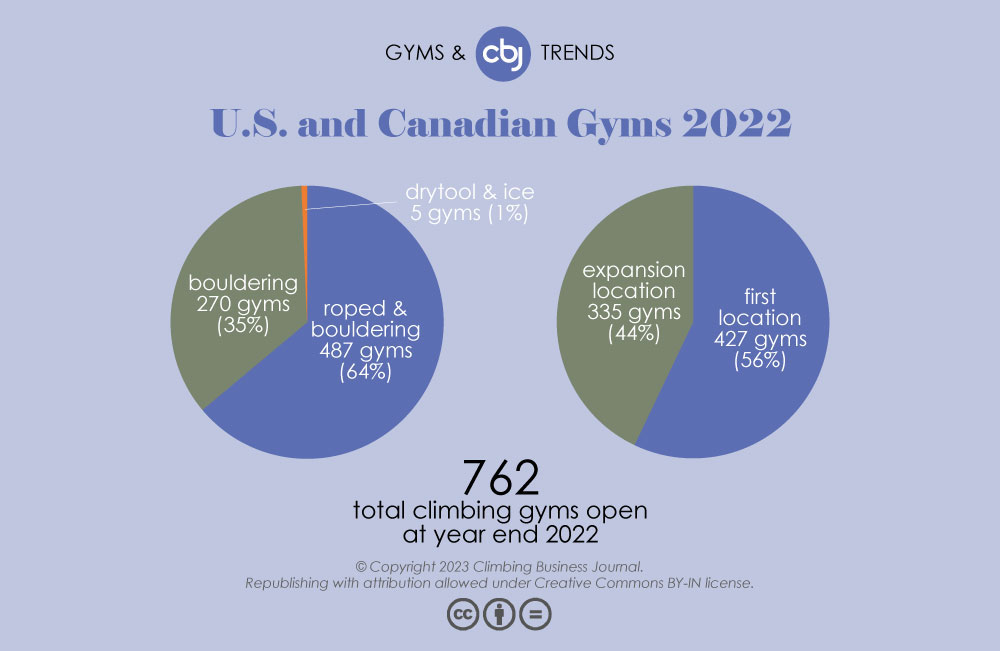
6.46% was the average annual net gym growth rate in the U.S. over the past 5 years (lowest of past 10 years)
Still, it is worth noting that, even when stepping back and looking at average annual growth over five-year intervals, the net climbing gym growth rate from 2017-2022―6.46 percent―was the lowest of the past ten years and has been steadily on the decline for five years. It’s fair to wonder, then, whether certain climbing gym markets may finally be starting to reach saturation following the industry’s golden growth years. Most of the experts we heard from, however, don’t think so.
“I see a lot of expansion in the plans for a lot of gyms,” Mike Palmer at Cascade Specialty told CBJ. “I think within 3-5 years we’re going to see some saturation in some markets, but I think it will be a few years. Right now, there is a lot of money chasing market share. Hopefully when they see the numbers in a few years, their return on investment pans out.” Mack Maier, COO and co-founder of HMH Outdoors, said, “We aren’t there yet in any major market, but I’m sure Chicago will be the one to watch.”
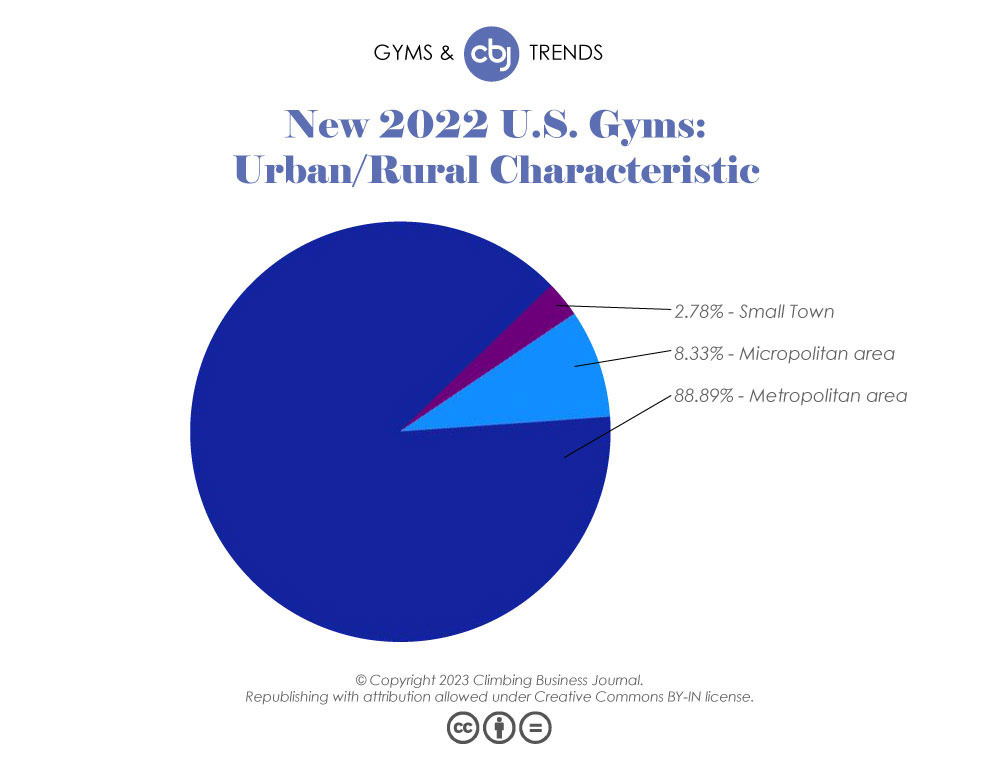
In the meantime, climbing gym developers may be picking the low hanging fruit by targeting less crowded climbing gym markets in major cities. All but four new climbing gyms in the U.S. last year (Gravity Lab, Recreate Climbing & Fitness, The Mountain Project and Volta Climbing) opened in a metropolitan area, and the 42 new climbing gyms in the U.S. and Canada spanned 26 states/provinces, the broadest spread of new gyms in over ten years. Coupled with the fact that permanent gym closures were few and far between last year, it’s safe to say the ceiling of market size even in more crowded markets like Boston and New York―which both welcomed new gyms in 2022―remains to be seen.
“I believe we are only scratching the surface,” said Lucas Kovalcik, founder and CEO of The Gravity Vault, which oversees 12 facilities and has a half dozen more on the way. “Climbing gyms with concepts and programming that cater to new and experienced climbers alike still have an abundance of opportunities to develop new facilities across the United States and worldwide.”
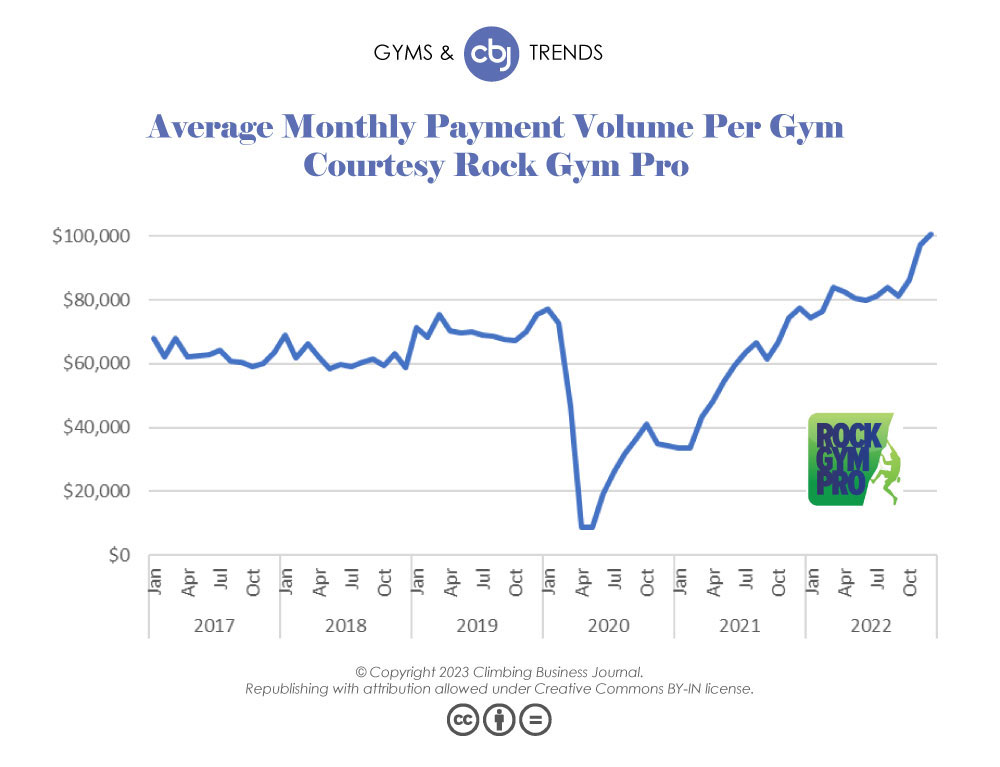
Additionally, it’s important to keep in mind that gym growth in the climbing industry remains strong when compared to related industries, such as the fitness industry (which based on The Global Health & Fitness Association (iHRSA) data shrank annually by 4.2% on average over the past five years). Traditionally, in more mature industries like the fitness industry, growth is measured in terms of total gym revenues and gym goers, and there too the climbing gym industry has been standing out in recent years. Based on Rock Gym Pro data, average total revenues per climbing gym were estimated to be 19% higher in 2022 than they were in 2019, whereas fitness industry revenues haven’t yet rebounded to pre-COVID levels based on most estimations. And according to an Outdoor Industry Association 2022 report, the number of indoor climbers grew annually by 3.03% on average over the past four years, which is more than the 2.22% growth in fitness gym members over the same four-year period based on data in an iHRSA 2022 report.
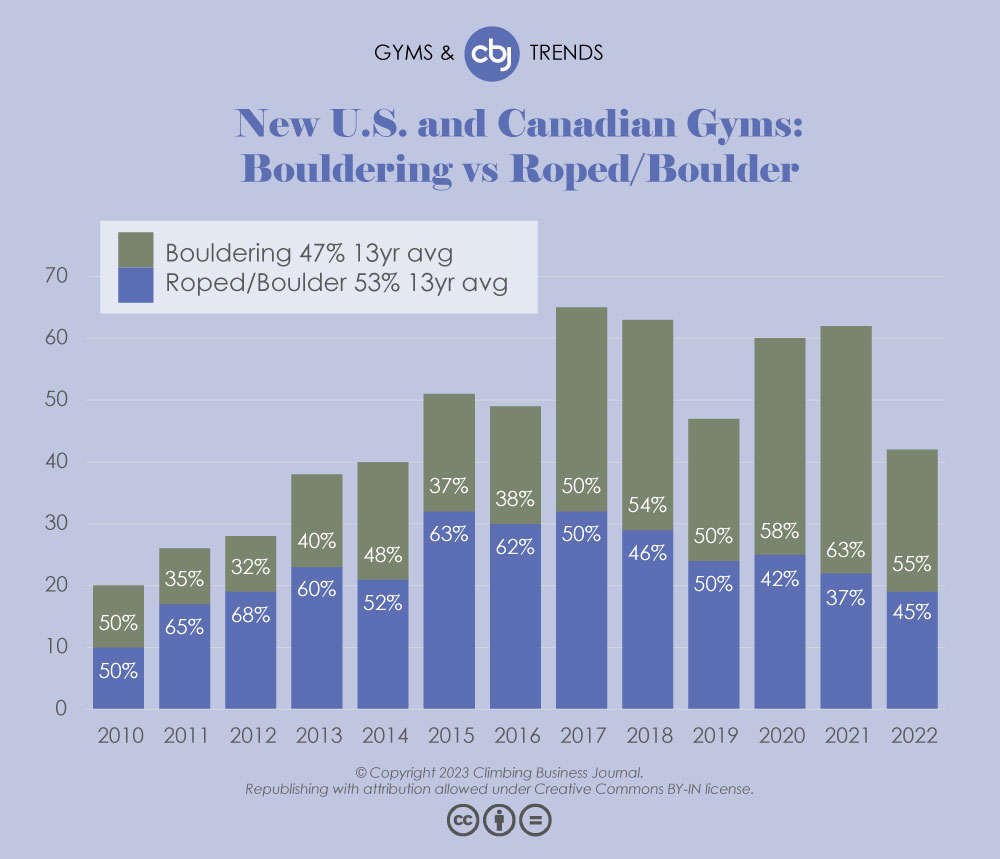
50% of new U.S. and Canadian gyms over the past 10 years were bouldering gyms (all-time high)
One of the big trends observed in the North American climbing gym industry since the start of the 2010s has been the steady rise in smaller, bouldering-focused gym builds. Over the past ten years, especially, the prevalence of new bouldering gym openings compared to openings of new roped climbing gyms and new mixed climbing gyms (meaning gyms that offer both boulders and ropes) has never been greater. From 2013-2022, 50% of the new climbing gyms that opened across the U.S. and Canada were bouldering gyms―an all-time high.
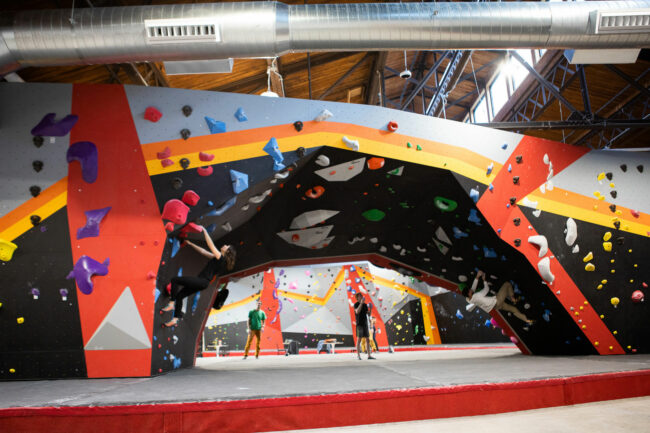
“Bouldering still seems to be the fastest growing segment in the industry,” said Rich Johnston, founder of Elevate Climbing Walls and the Vertical World gyms, who added that “the overall trend is moving the sport further away from the historical and legacy foundation of the sport.”
It’s worth noting, however, that even during the bouldering boom’s peak period thus far in terms of new gym development, roped and mixed gym growth (50%) was still equivalent to bouldering gym growth over the same ten-year period. In 2022, as well, half of the new climbing gyms in the U.S. were roped or mixed gyms (18). The largest of these new gyms, Movement Design District in Dallas, Texas, offers 35,880 square feet of total climbing surface; the tallest new gym, projectROCK Easley in South Carolina, boasts climbing walls towering as high as 84 feet. (Click here for all the 2022 Gyms List Awards.)
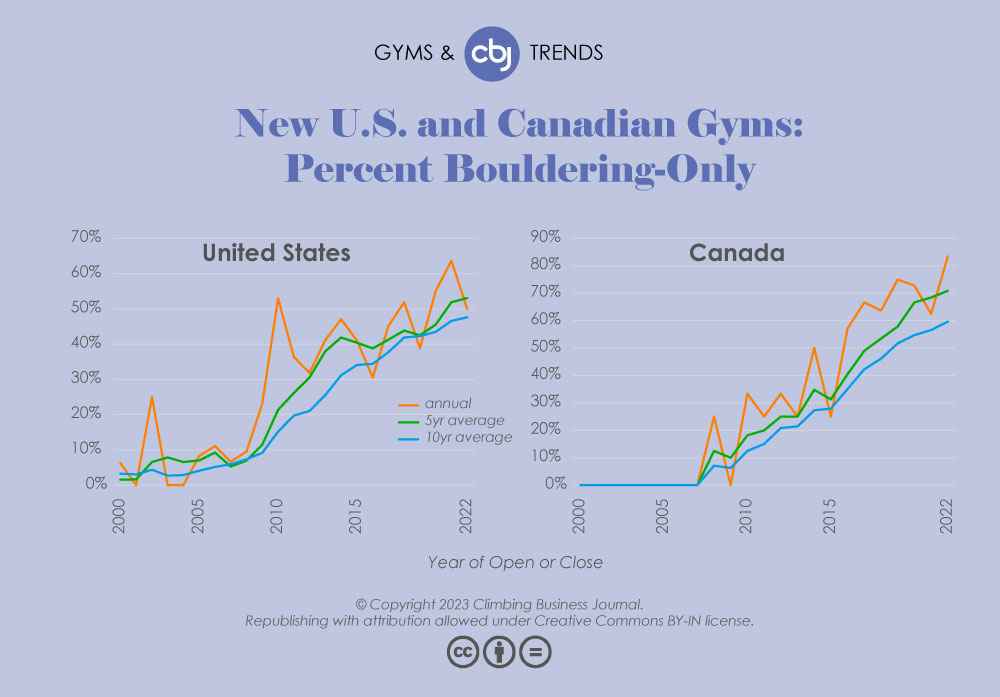
Larger gyms with roped climbing, then, continue to have a strong presence in new climbing gym development stateside. Multiple experts we heard from also pointed out how larger and smaller gyms in the same climbing gym market can complement one another through differentiation of their services and a “rising tide lifts all ships” effect on climbing gym membership in the area.
“I think as the industry grows so too does specific brand identities. Some brands are geared toward families and kids, some toward newcomers, some exclusively toward experienced climbers and training, while others are developed as boutique fitness facilities with a focus on climbing and others are a blend of several of these,” said Lucas Kovalcik at The Gravity Vault. “Climbing gyms are beginning to take on the differentiation we see in traditional gyms…While the core offering is climbing, how it is curated can be very different, which I think is great and how it should be. It is great for the sport, great for the market and great for the climber looking to find their given climbing community.”
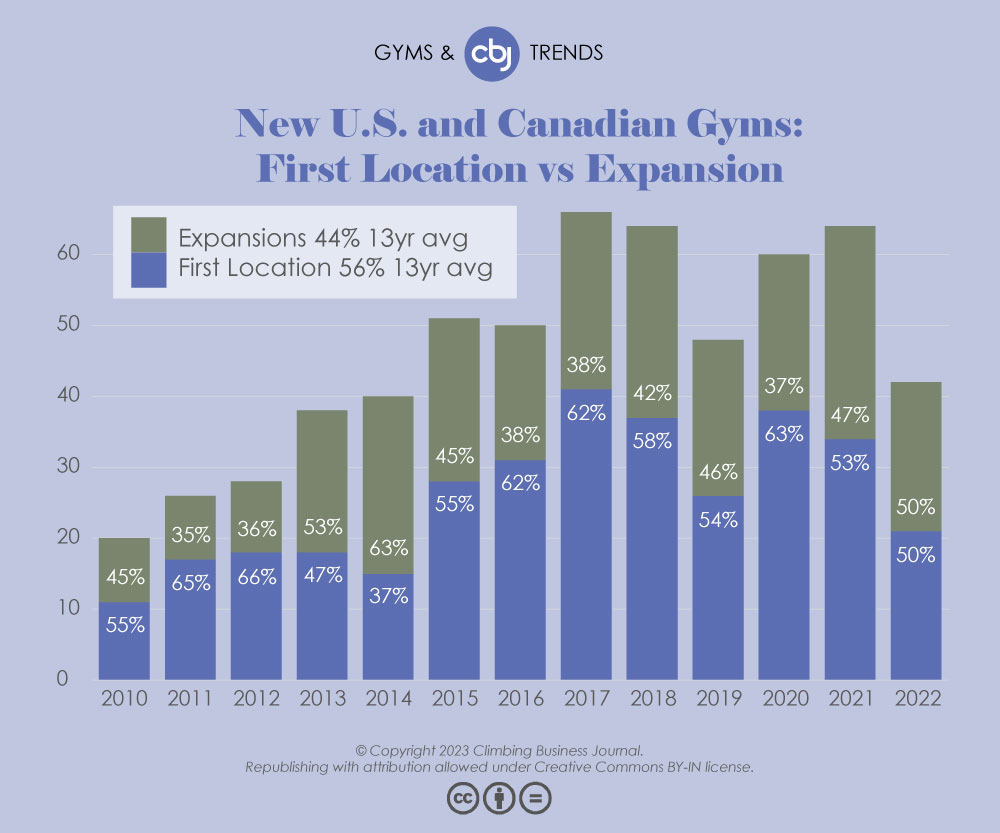
45% of new U.S. and Canadian gyms over the past 10 years were expansion gyms (nearly all-time high)
Alongside the rise in bouldering gym builds in North America is the expansion of chains of two or more climbing gyms. From 2013-2022, 45% of new climbing gyms in the U.S. and Canada were expansion gyms (as opposed to first-location gyms), which is just shy of the ten-year all-time high set in 2006-2015 (46%). In fact, expansion gyms have accounted for at least a third of annual new climbing gym builds across the U.S. and Canada for the past fifteen years. Currently, the largest climbing gym chains in North America are Movement (20), Central Rock (18) on the East Coast, and Touchstone (15) on the West Coast―all of which added new gyms in 2022.
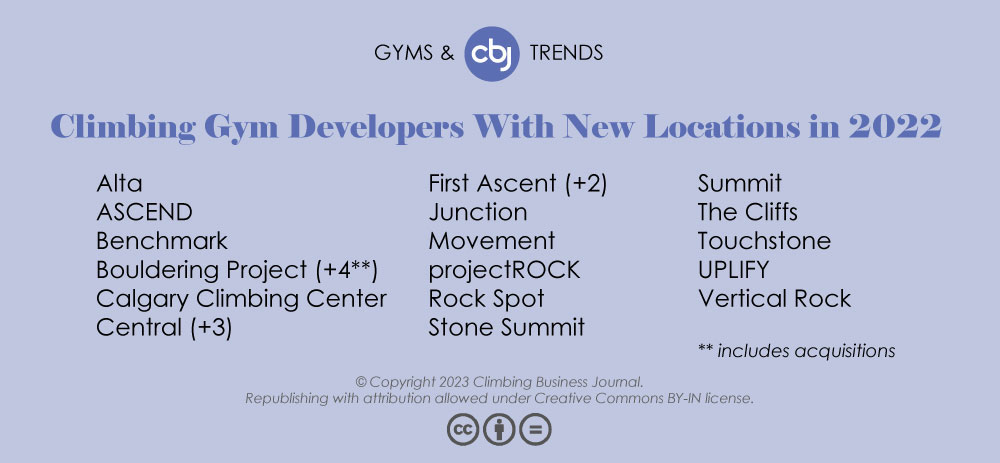
“We seem to see a lot more expansion of climbing gym chains than newcomers…” said Vincent Legare, CEO of DÉLIRE climbing gyms. “Existing climbing gyms acknowledge the advantages of adding a new facility in terms of leveraging expertise, retaining employees, and growing a community. This will probably be the trend for the next few years…”
Acquisitions of existing climbing gyms, as well, have taken place each year of late. “It seems that several gyms are selling,” Mack Maier at HMH told CBJ. And Rich Johnson at Elevate and Vertical World said, “There seems to be a shift to venture capital moving into the industry.”
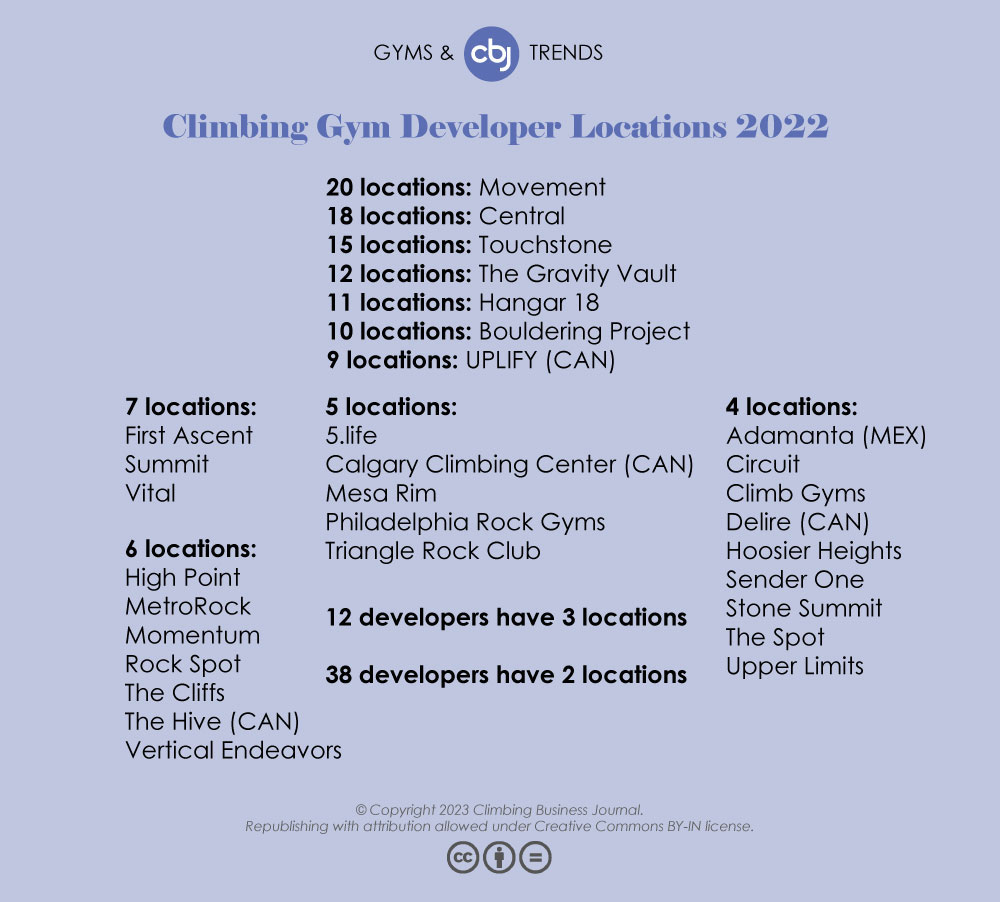
In 2022, the headline acquisition was Bouldering Project taking the reins of three Brooklyn Boulders gym properties―two of which offer roped climbing. Paired with the opening of its new location in Salt Lake City, Bouldering Project added more climbing gyms to its name last year (4) than any other gym chain. In total, Bouldering Project now operates 10 gyms across Seattle, Austin, Minneapolis, Salt Lake City, Brooklyn, Boston and Washington D.C.
Still, while the “mom-and-pop” gym businesses of the ‘90s may not be as common today, new first-location gym builds have still outpaced new expansion gym builds in North America over the past ten years (55%). What’s more, since the very first North American climbing gyms opened 35 years ago, new first-location gym openings have been surpassed by new expansion gym openings in only two of those years (2014 and 2013). Similar to the bouldering discussion, at least while climbing gym markets still have room to grow, smaller climbing gym businesses can co-exist alongside larger ones by catering to a specific segment of the market―and keeping up with the times.
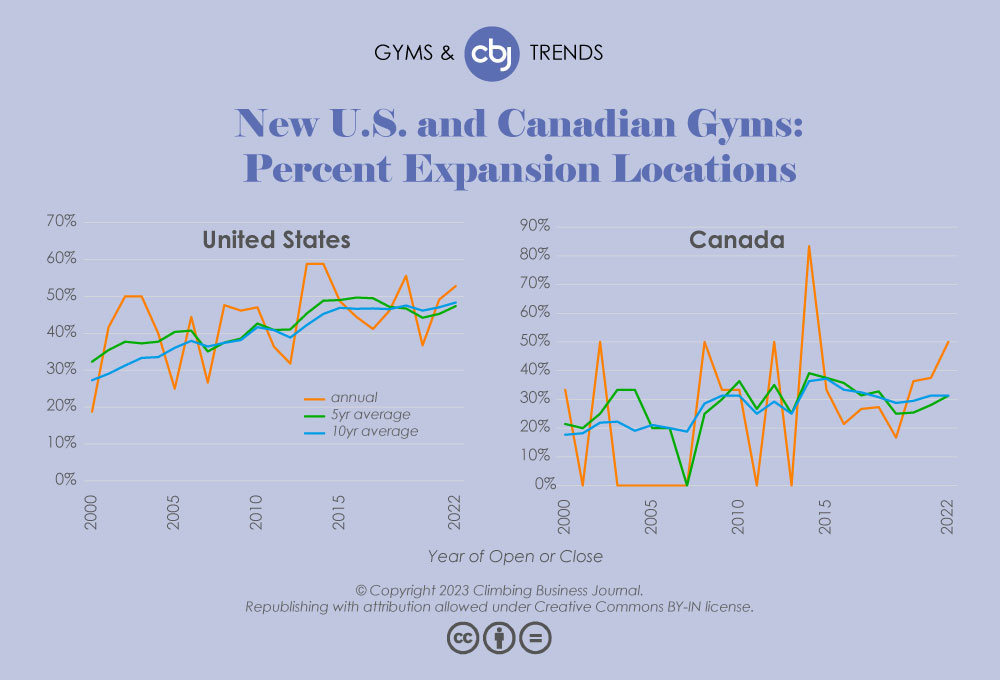
“Existing gyms will need to keep investing in their facility to keep it up to date with the market,” continued Legare, suggesting incumbent gyms consider “replacing old funky wall design with new modern walls, adding a lot of new holds each year, installing the latest adjustable walls, investing in the rotation and quality of routesetting, engaging with the community through member-oriented happenings and partnerships, and working on staff attraction and retention.”
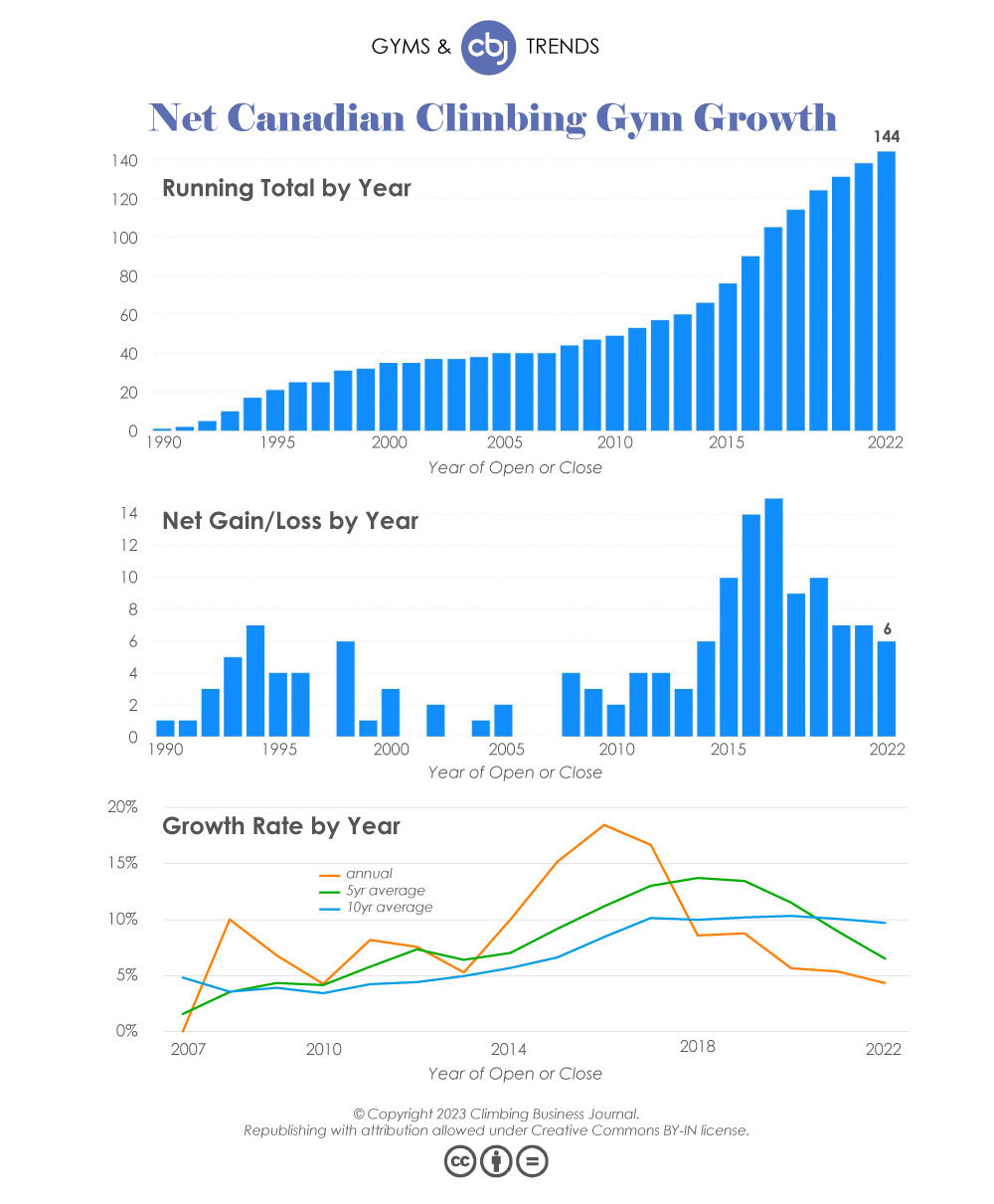
9 net new gyms opened annually in Canada on average over the past 10 years (all-time high)
North of the U.S.-Canada border, climbing gym development has followed a similar trajectory as in the U.S. On average, more net new climbing gyms opened annually in Canada over the past 10 years (9) than any prior ten-year period, following 6 new gym openings in 2022. And although the five-year average annual net gym growth rate in Canada―6.52% from 2017-2022―has been in decline the past four years, the annual net gym growth rate of 4.35% in 2022 was kept on par with the U.S. growth rate due to the few permanent climbing gym closures in Canada as well―zero, in fact.
The similar growth rates in Canada are impressive given that the country was generally slower than the United States to lift its strictest pandemic restrictions. “Money lenders are typically more risk-averse in Canada than in the U.S. during COVID; borrowing money, signing a lease, or starting a first business was much, much harder than usual,” shared Abel Chouinard, CEO and co-founder of LEMUR Designs, who observed some gym projects being canceled or postponed.
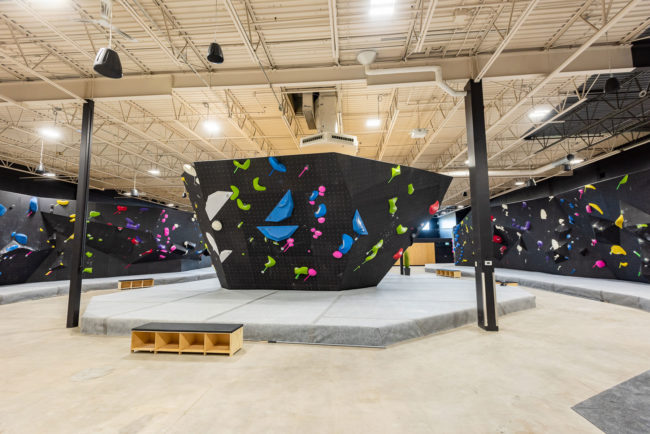
“As with many industries, supply chain issues have been a major challenge in 2022. We have seen longer lead times, pricing increases, as well as higher shipping and fuel costs,” said Kyle Wilson, CEO and founder of IMPACT Climbing Walls. “In contrast, economic downturns can also present an opportunity for businesses,” added Wilson, referencing “favourable exchange rates with comparatively strong currencies.”
Of recently completed projects, bouldering gyms have been even more popular than roped/mixed gyms in Canada than in the U.S. Over the past ten years, new bouldering gym openings represented a whopping 60% of new climbing gym openings in Canada. Expansion gyms, by contrast, accounted for less than a third (31%) of new gyms over the same ten-year period.
As for location, the province of Quebec had more new climbing gym openings in 2022 than any other province (3). Other news out of the province last year was the expanding presence of Quebec-based gym builders and designers Onsite and DÉLIRE Climbing Walls into U.S. climbing gym markets. Combined, the two companies and Ontario-based IMPACT were chosen for over a quarter (26%) of all new climbing gym builds in 2022 across the U.S. and Canada (6 by Onsite, 3 by IMPACT, 2 by DÉLIRE); seven more planned climbing gyms, as well, have already been announced by the Quebec-based companies (5 by Onsite, 2 by DÉLIRE).
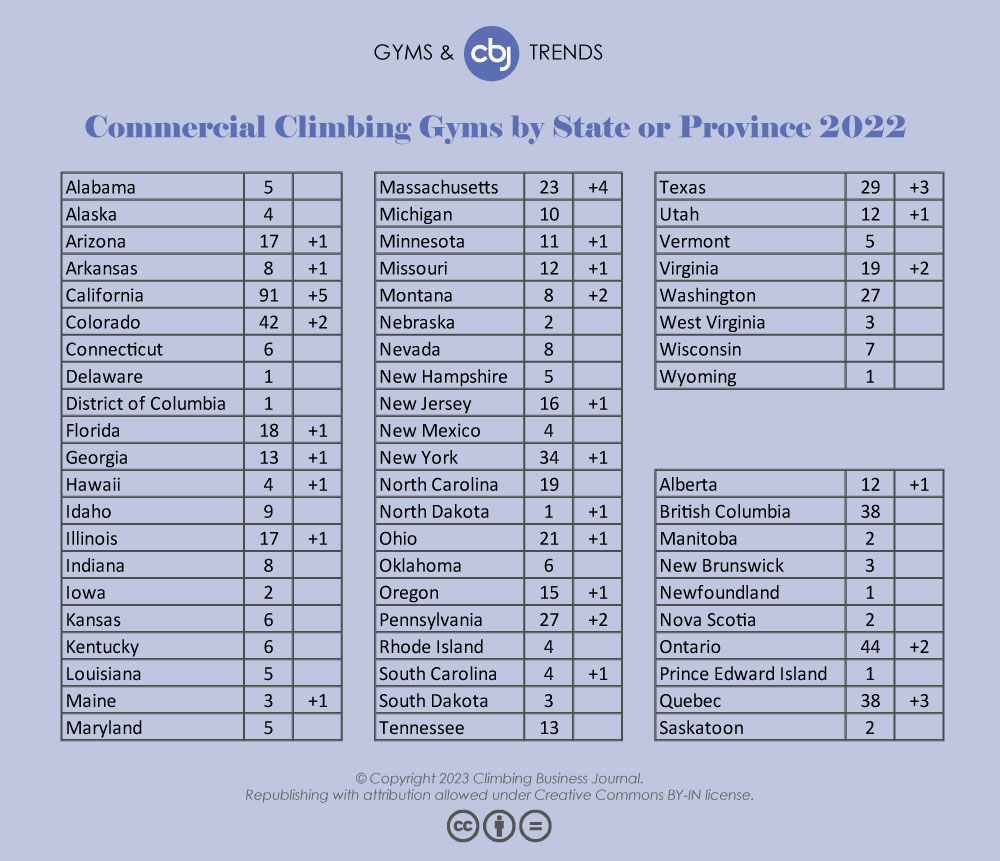
Francis Larose, founder of OnSite, doesn’t expect the uptick in demand for new climbing gym builds to slow down in the immediate future. “A lot of people are looking at the ‘saturation’ metric now (climbing gyms per capita in a metropolis). But until we see failure and the first gyms closing because there are too many, we can’t say when we will reach it.” Larose added that “Montreal will be a very good test in the next years,” noting the city already has several climbing gyms.
Patricia Morin, Marketing & Sales Coordinator at DÉLIRE, expressed similar optimism when asked about potential saturation. “I don’t think we’re there yet in North America,” Morin said. “Climbing is a sport that is still unknown to the general public. We still have a large bank of potential climbers who don’t yet think of climbing as a training or sport possibility.”
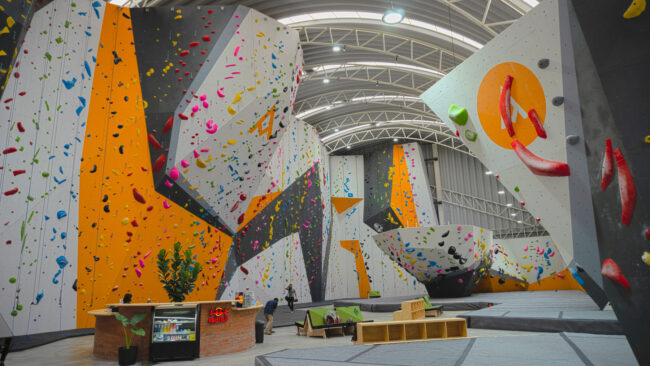
2 new climbing gyms opened in Mexico in 2022
At CBJ we were pleased to learn more about climbing gym developments in Mexico last year, as well, a country which we admit has not received enough attention in our Gyms & Trends reporting on North American markets. 2022 was a pivotal year for the climbing gym industry in Mexico, as the current number of climbing gyms in the country that we know of reached an all-time high: 29 facilities. Significant among the openings were two new Adamanta gyms—in Puebla and Satélite. (The two other Adamanta locations, in Santa Fé and Escandón, opened in 2014 and 2019, respectively.)
The total of four Adamanta gyms in 2022 makes Adamanta the largest climbing gym operator in Mexico. Adamanta’s CEO, Jose Saucedo, cites climbing’s increasing popularity in Mexico—similar to that in other countries—as a contributing factor to his company’s expansion. He also acknowledges the vibrant climbing communities around Mexico.
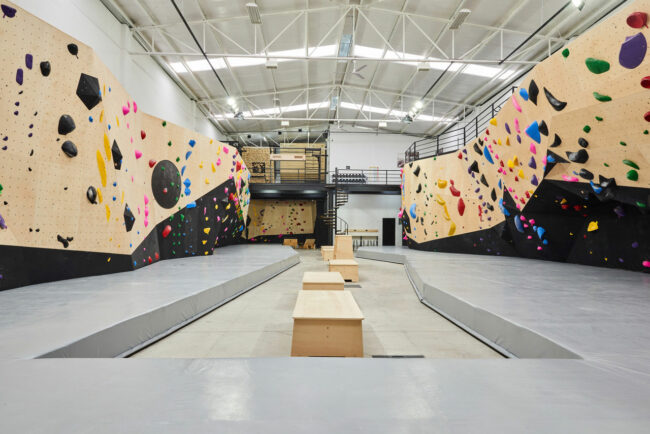
“Our community is the backbone of our growth philosophy,” Saucedo told CBJ. “Whenever we are faced with the decision to open a new gym, we have to assess whether there’s potential to build and nurture a community as healthy as the one we currently have. We have to be convinced that we will be able to connect with the local crowd at each facility.”
Javier Serratos, who with his wife—Quetzali Galindo—founded Toka, a climbing gym in Mexico City, notes that indoor climbing in Mexico has crossed a significant threshold; gym climbing is no longer an activity that exists solely in the country’s main cities. “Today, it is possible to find walls and climbing areas in practically the entire country,” Serratos said.
In 2022, Toka completed a massive renovation and enlargement, the result of Serratos and Galindo purchasing property adjacent to the original gym space. [To read a more detailed account of Mexico’s climbing gym history and growth, click here.]
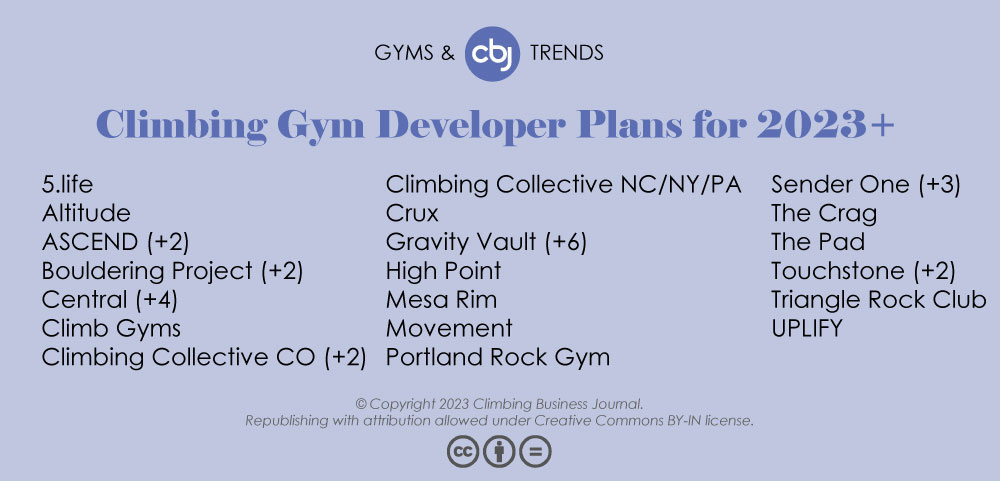
Looking ahead: 50 new climbing gyms are planned to open in the U.S. and Canada in 2023+
While 2022 had innumerable challenges, 2023 is poised to be a fascinating year in its own right, with more signs pointing to the climbing gym industry’s continued positive trajectory. At the time of this writing, 43 new gyms are planned to open in the U.S., and 7 gyms are planned to open in Canada. If all those projects come to fruition, 2023 will likely see more new gym openings stateside than last year, and more gym projects always pop up throughout the year. (Readers can find nearby planned climbing gyms on the CBJ Gym Map, shown in pink.)
2023 will also see the beginning of the qualification pathway for the 2024 Olympics, a spotlight that will undoubtedly vault climbing into the mass public-consciousness just like it did for the Tokyo 2020 Olympics. “Following the Olympics, we saw a bump in interest in the sport, and that has generated demand for competition-style walls,” Kyle Wilson at IMPACT said.
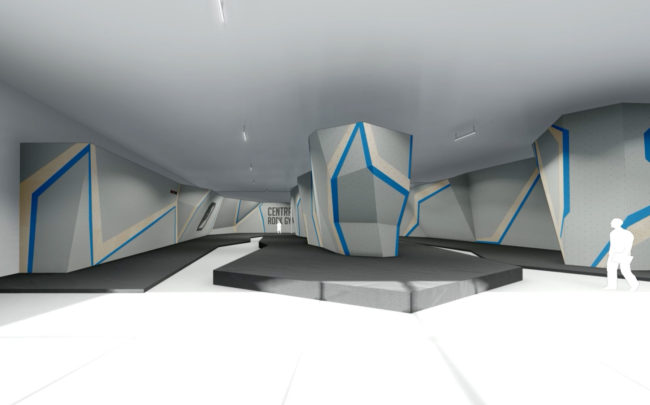
Whether or not the reigniting of Olympic hype in 2023 will translate to more climbing gym development and patronage at existing gyms remains to be seen, but we will certainly follow it. Already, we’ve seen much optimism from brands and developers. “Big events—like the arrival of climbing at the Olympic Games—will certainly contribute to creating new adapters,” said Jeff Beaulieu, co-owner and designer of DÉLIRE Climbing Walls. “Climbing has been democratized for years, and great exposure like this certainly helps bring new climbers into the gyms.”
New technological advances, as well, are always on the way, keeping business leaders on their toes. What will characterize the climbing gym industry of five to ten years from now? “More technology in the gyms and more science in the high-level climbing,” predicts Abel Chouinard at LEMUR Designs. “Similar to cycling or running, data analysis in training and data acquisition technology will see a huge increase in popularity. The climbing gyms will also attract a more diverse audience which will create more diversity in the offering.”
While every macro and micro-level change brings with it an altered landscape for climbing gym and brand businesses to navigate, the industry has come a long way since our first Gyms & Trends report in 2013 and is hopefully more equipped than ever to face the next set of challenges. “The dirtbag climbers have turned into professionals,” summed up Allison Justice, Marketing Director of EP Climbing USA. And we would add, there’s still more work to be done.
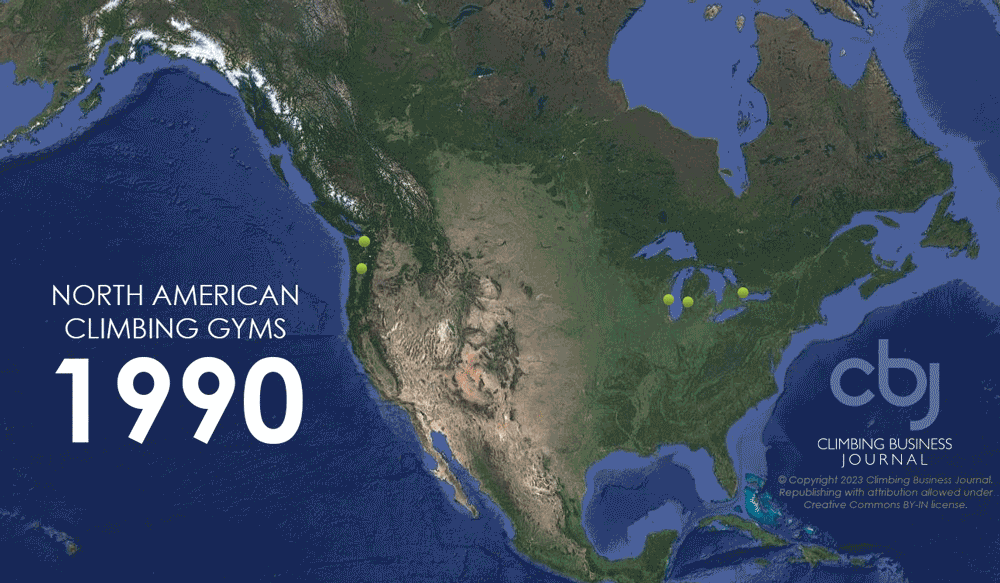
Behind the Data
CBJ is dedicated to researching and accurately reporting on climbing business activity in the industry. We strive to always be data-driven. The industry growth rate and accompanying data were compiled through several different source avenues and are completely original and proprietary to CBJ. Any climbing gym is welcome—and encouraged—to update or add their information to CBJ’s comprehensive gym map and dataset here. For more information about the methodology behind the data, please visit the methodology section of Gyms & Trends 2019.
That being said, CBJ acknowledges that there are limitations to this research. On the whole, climbing gyms are privately owned and operated businesses, which complicates the gathering of data. Additionally, although the metric of “square footage” is generally acknowledged as a principle measure of growth (whether square footage of floor plan or square footage of climbing wall surface area), “quantity of foot traffic” and revenue are other metrics that could be considered—albeit still with complications in the data acquisition. A key datapoint that is publicly available and most easily verified is the number of commercial facility locations; for that reason, it is CBJ’s primary research metric. (There are limitations to this metric as well, as it does not include climbing walls and facilities operated by colleges, universities, municipal recreation centers, private fitness clubs, etc.)
Thank you to everyone who has supported and furthered this research, including the researchers who devoted many hours to collecting and fact-checking the gym data and the industry insiders who contributed keen insights, observations and opinions on the industry activity of 2022. And thanks to the team who has long supported CBJ’s research, in particular CBJ publisher Scott Rennak, CBJ founders Mountain Helt and Marlowe Kulley, map data guru Jon Lachelt, as well as John Burgman, Joe Robinson, Jamie Strong and Naomi Stevens.

Climbing Business Journal is an independent news outlet dedicated to covering the indoor climbing industry. Here you will find the latest coverage of climbing industry news, gym developments, industry best practices, risk management, climbing competitions, youth coaching and routesetting. Have an article idea? CBJ loves to hear from readers like you!









